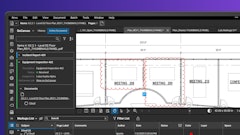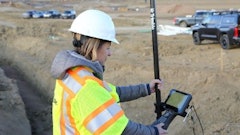
You know that urge you have to be on all your jobs so that you'll know what's going on in the field? That urge to know how hard your guys are working? That urge to know what they really spend their time on?
Your urge is justified and you need to satisfy it - but not by going into the field.
You can satisfy your urge to know EXACTLY what's getting done from the comfort of your office chair. You've just got to know the trick...and THAT my friend is what we're going to work on today.
We're going to show you how to get your guys to send in good, valuable data. Data that reveals whether they were productive, hard working, and are on schedule.
To be completely truthful, the system that tracks your guy's efforts and performance has three parts. This is the final piece of the system.
Previous articles addressed the reports you need and another discussed how to focus your guys on their day's production target(s). Today, it's about convincing them to submit honest and complete production reports.
As you have probably discovered years ago, getting truthful production feedback from the field is HARD to do. Trust us. Although hard, it is far from impossible. It IS going to require some psychology, people skills, and tough love.
To begin with, be aware that field crews HATE recording stuff.
Stuff like, well you know, the amount of material they put in; what they spent their time on; the equipment they used; the delays they ran into. If construction workers liked paperwork, they'd be sitting behind a desk. They don't, so they aren't!
Field workers consider paperwork to be a huge waste of time. They don't see how the data collection affects them or their livelihood. That's buy-in hurdle number 1. That's a relatively easy hurdle to overcome.
Buy-in hurdle number 2 is far more difficult to overcome. Employees are paranoid about collecting data that could be used against them. They are not going to be thrilled about handing a loaded gun over to the enemy (management).
A little insight into what goes through your typical worker's mind when asked to self report performance.
"They just want to build a case to fire me."
"They are going to use it to set impossible goals."
"They are never going to understand all the cr*p we have to put up with out here."
Overcome Buy-in Hurdles Using Two-step Attack Strategy
First step, answer the age old question "What's In It For Me?" (known as WIIFM and pronounced as whiff-em). Tell them performance reporting provides,
- Better work. "It keeps us from blowing bids."
- Job security and more hours. "It helps us grow the company."
- The thrill of victory. "You will know when you've beaten the goal."
- Better planning. "Good data lets us set realistic schedules."
- Realistic performance standards. "Good data lets us set performance goals that are fair and reasonable."
- A foundation for performance based bonuses. "We can share the profits when you beat the budget."
Second step, minimize the amount of time it takes them to fill out the report. They can't really complain that a task wastes time if it only takes them 15 minutes a day to do it, now can they?
To shorten the time commitment, obey the following rules
- Keep the process and forms simple.
- Only collect the information you really need.
- Set clear roles and responsibilities for data collection.
- Let the field leaders practice filling out the forms. Coach them as needed.
- Collect data only on the four to six critical benchmark tasks that make or break the job.
- Listen to your field workers' improvement suggestions.
You must make recording the data easy. The easier the data is to record, the more likely your crews and foremen will record it accurately.
Remember, garbage in means garbage out. To get your crews recording data correctly, obey four rules-of-thumb.
1st rule: Keep the forms easy-to-use.
2nd rule: Design the forms to collect the exact data you need.
3th rule: Pre-print the forms complete with repeating numbers (like the project).
4th rule: Use coding systems and reference cards.
So what makes a form easy-to-use?
- It has plenty of space to write in the required information.
- It flows naturally from left-to-right and top-to-bottom.
- It doesn't use unfamiliar abbreviations.
- It contains lines to help keep data in their proper space.
Take a close look at your current timesheet. Does it possess the characteristics of an easy-to-use form? If not, create a new timesheet.
One other issue for you to be aware of: Timesheets that are easy to fill out often are difficult to input payroll data from. Sacrifice ease of data entry for ease of data recording.
Warning - do not sacrifice ease of field recording for ease of computer entry, no matter how loud your accounting and clerical staff complains!
Use Reference Codes
Writing a number down is far easier and faster than writing down a word. Numbers take up less room and are easier to read. To make the numbers easy to remember, give your field team reference cards that contain indexes linking:
- Employee name to employee number
- Project name to project number
- Work activity description to cost code number
- Material description to material number
- Equipment description to equipment numbers
- Approved benchmark codes for the project
Reference lists need to be available. Keep blank copies of all forms with the reference cards.
Provide enough copies of the reference lists so that each gang box has one, the job trailer has one, the foreman has one in his clipboard, and each major piece of equipment has one in the cab. On projects that run over a month, you will find laminating the reference cards to be well worth the cost.
Moving on to the inevitable, one or more of your foreman refuses to submit complete and accurate data. What to do? Time to tap your inner boss. Hold the offender(s) accountable. State your position very clearly and concisely. "Help us collect good data or you will be asked to leave the company."
Don't duck the issue. Don't let anyone off the hook for any reason. It only takes one exception to undo all of your progress. Don't let your clerical staff undermine the process. They will want to simplify it. Don't let your estimator undermine the process. He will want to complicate it.
Stick to Your Guns
You KNOW performance tracking is essential for long term business success. It is the foundation for estimating, scheduling, budgeting, and incentive programs. There you go. You now have your roadmap for getting good data from the field. Follow it to much success.





















